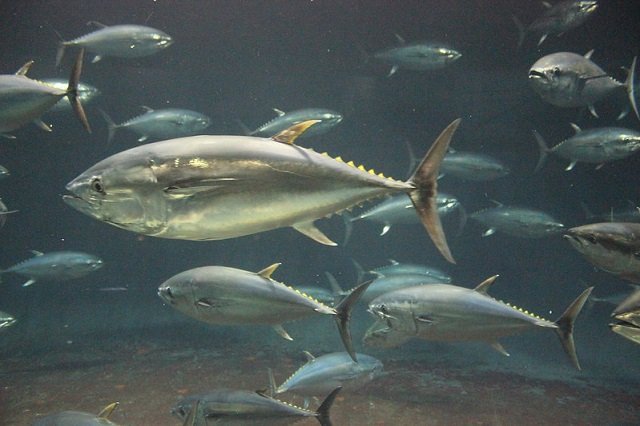Norway.- There are several ways to farm a salmon. Here is a short explanation to four different fish farming systems in use and under development in Norwegian salmon farming.
Traditional fish farming is when salmon fry are kept in land-based tanks (in practice a closed containment fish farm onshore) with water flowing through until the fish reaches the smolt stage and weighs around 80–100 grams, after which it is transferred to open net-pens in the sea. The salmon lives there until it reaches its harvesting weight of 4–5 kilograms. Fresh ocean water flows continuously through the net-pen, and the fish living inside are quite subjected to the forces of nature. One drawback to this is that waste and infections are freely exchanged with the surrounding environment. In addition, the walls of the net-pens can be damaged and fish escape. Benefits of such fish pens include the fact that they represent the cheapest method for farming salmon, and allow the fish to live as close to nature as possible. Such traditional farming is by far the predominant method used in Norway currently.
In closed containment facilities onshore it is possible to keep salmon until it reaches its harvesting weight of around 4–5 kilograms. However, in Norway today it is more common to farm up to approx. one kilogram; known as the post-smolt stage. Such facilities are also called land-based facilities. They use water-recycling technologies to recycle up to 99.9% of the water used. These facilities require vast land areas and high expertise as well as significant economic investment and control with the technology, water quality, and health and well-being of the fish. We are able to capture more than 98% of the sludge generated in these facilities, but we have yet to find the best solution to dispose of or utilize it. Benefits of land-based closed containment facilities include the ability to completely avoid the issues of salmon lice and escaped fish, the ability to capture and potentially recycle nutrients contained in the sludge, and potentially the ability to produce more robust fish that is more capable of survival. One technical challenge researchers are facing is to supply the recirculation facilities (RAS) with seawater, which is what the fish naturally live in from the smolt stage onward. Further research needs to be done on this. Several large facilities for production of post-smolt (up to 1 kilogram) are currently being built in Norway, and in 2019 the first onshore fish farm will start farming salmon until it reaches its harvesting weight.
In closed containment fish farms at sea, which we usually refer to as semi-closed due to the fact that they do not contain the waste created, and are thus not completely closed, it is possible to set out smolt and potentially keep them there until they reach a weight of one kilogram. In practice they currently work best as a stopover stage for salmon weighing between 250–500 grams. Researchers have succeeded in producing fish entirely free of salmon lice and without escapes, but a number of technical issues remain to be solved. The benefits of closed containment facilities at sea is that they utilise deep sea water from depths where lice cannot live, and they do not require the extensive water purification technology that land-based recirculation facilities do. A solid wall separates the sea environment from the fish on the inside of the facility, and prevents any interaction with the outside environment. Several varieties of prototypes for closed containment facilities at sea exist, but none of them are currently in commercial production.
Farming in exposed facilities far offshore is driven by the need for increased space and better production environments. Exposed localities provide more stable growth conditions and greater distribution of waste due to the fact that the sea is constantly in motion. In addition, exposed facilities can be located farther away from the wild salmon in the coastal areas, which can help reduce the negative environmental impact caused by salmon lice and fish escaping from the net-pens. However, this kind of facilities is also associated with challenging conditions for its operations, structures and equipment due to strong and alternating winds, currents and waves, in addition to the increased distance to the facilities. Farming in exposed localities requires new technical solutions combined with operational concepts for maintaining security and ensuring production reliability. Commercial salmon production is currently tried out in experimental net-pens. Read more at https://exposedaquaculture.no/en/ .
Contact person
Åsa Maria O. Espmark
Senior Scientist
Phone: +47 991 60 039
asa.espmark@nofima.no
Source: Nofima
Editor at the digital magazine AquaHoy. He holds a degree in Aquaculture Biology from the National University of Santa (UNS) and a Master’s degree in Science and Innovation Management from the Polytechnic University of Valencia, with postgraduate diplomas in Business Innovation and Innovation Management. He possesses extensive experience in the aquaculture and fisheries sector, having led the Fisheries Innovation Unit of the National Program for Innovation in Fisheries and Aquaculture (PNIPA). He has served as a senior consultant in technology watch, an innovation project formulator and advisor, and a lecturer at UNS. He is a member of the Peruvian College of Biologists and was recognized by the World Aquaculture Society (WAS) in 2016 for his contribution to aquaculture.
Stay Always Informed
Join our communities to instantly receive the most important news, reports, and analysis from the aquaculture industry.




